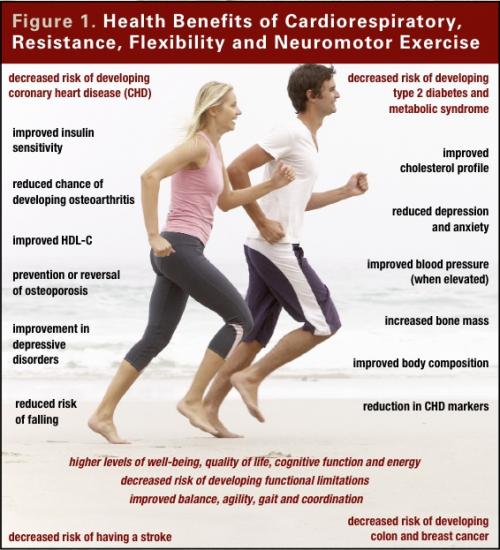I know you count on me to get important, relevant and real (as in hype-free) fitness news into your hands.
So when one of my professional journals arrived today with a full report on exercise guidelines from the American College of Sports Medicine (ACSM, the gold standard of fitness research) with the latest, I knew I had to get it to you straight away.
 10 years and over 400 reports to back it up
10 years and over 400 reports to back it up
This is impressive in its comprehensiveness. The new paper from ACSM, compiled to update the 1998 document on the same topic, cites over 400 publications from scientific reviews, epidemiological and clinical studies, meta-analyses, consensus statements and evidence-based guidelines. Whew!
The purpose of this ACSM Position Stand is to present evidence-based direction to health and fitness professionals on developing individualized exercise training programs for apparently healthy adults of all ages (Garber et al. 2011)
4 pillars of the ideal workout schedule
1) Cardiorespiratory exercise recommendations: There’s wiggle room with the specificity of these guidelines for aerobic exercise, yet they all make sense because they are based on the variables of duration and intensity. Detailed breakdowns are included in the report, but to simplify things:
- aerobic exercise of moderate intensity for 30 to 60 minutes at least 5 x a week, or higher intensity for 20 minutes 3 times per week, or some combination of these
- cardiorespiratory exercise is described as “purposeful, continuous, rhythmic exercise involving the major muscle groups”. To me that means walking, biking, swimming, running, skiing, elliptical. No stop and start. See Confused about cardio: My conversation with Dr. Kenneth Cooper.
2) Resistance exercise recommendations:
- for resistance training, hit the major muscle groups 2 – 3 times a week
- rest for 48 hours between muscle groups
- intensity at 40 – 50% of your one-repetition max (1-RM) for strength- that means the most weight you could lift for one repetition. Your workload of resistance in weight training is thus a percentage of that
- 8 – 20 repetitions, depending on your goals. Also see Light weight and high reps or heavy weight and low reps to make muscle? (video)
3) Flexibility exercise recommendations:
- target the major muscle groups 2 – 3 times a week with stretching
- stretch to the point of slight discomfort or feeling of tightness in the muscle
- a total of 60 seconds stretching time per target muscle group
4) Neuromotor exercise recommendations: This is the new kid on the block, the benefits and recommendations of which have been expanded in this version of the ACSM guidelines
“Neuromotor exercise” is another name for functional exercise. Exercise that focuses on balance, agility and coordination. Think yoga, pilates, tai chi, physical therapies. The type of training can improve balance, agility, muscle strength, gait and coordination, and reduce the risk of falls.
- 20 minutes on two or more days per week
This is just a snapshot of the ACSM report
There are 18 lengthy sections to the ACSM Report on Guidance for Exercise Prescription. Whew is right.
What I’ll do for you is elaborate on details as we move forward and continue to share with you juicy tidbits and news you can use.
And I’m all over it. I’ve already been in correspondence with Len Kravitz, PhD, from the University of New Mexico, who authored a superb analysis of the ACSM data and who is one of my most trusted advisers via IDEA Health and Fitness Association.
Personalize your workout schedule
To help you personalize your workout schedule based on the ACSM guidelines, see the example here: How to create your own simple all-the-bases-covered workout routine.
 About Lani
About Lani
Lani Muelrath, M.A., CGFI, CPBN, is the creator of Fit Quickies™ & the Body Shaping Breakthrough Kit, a FREE collection you can download instantly to learn Fit Quickie #1: ‘7 Seconds to a Flat Belly‘ and your Burst Training Guide: How to fit 45 minutes of cardio into only 15 minutes. You can access your free kit here: Body Shaping Breakthrough Kit




Thanks for simplifying this report. 400 sources compiled? One can only imagine!
I’m looking over my workout routine and seeing how it measures up. I do have a question about changing your workout routine. One workout routine I use says it’s all I need to do and it does everything in the same order every time. There are some variations, but it is essentially the same each workout. Does this matter?
Great article!
Diana
Hey Diana, thanks for your comments and I’m glad you like the report.
Mixing things up is important, and you should change out your routine every 4 – 6 weeks. The contraction of muscles that is your muscle fibers moving in and out of their interwoven connection get used to a certain rhythm, stress, load, and even angle and routine of your workouts. To keep the body on its toes and see continued change with challenge, you need to vary that by changing sequence, exercise (even if it targets the same muscles, you can do something slightly different as in approaching from a different angle), amount of resistance….You know how you try a new workout and you feel that good sore all over, even if you were ‘in shape’? That’s precisely an example!
Have fun mixing it up. And be prepared for some ‘good’ sore, or what I call ‘muscle awareness’. !